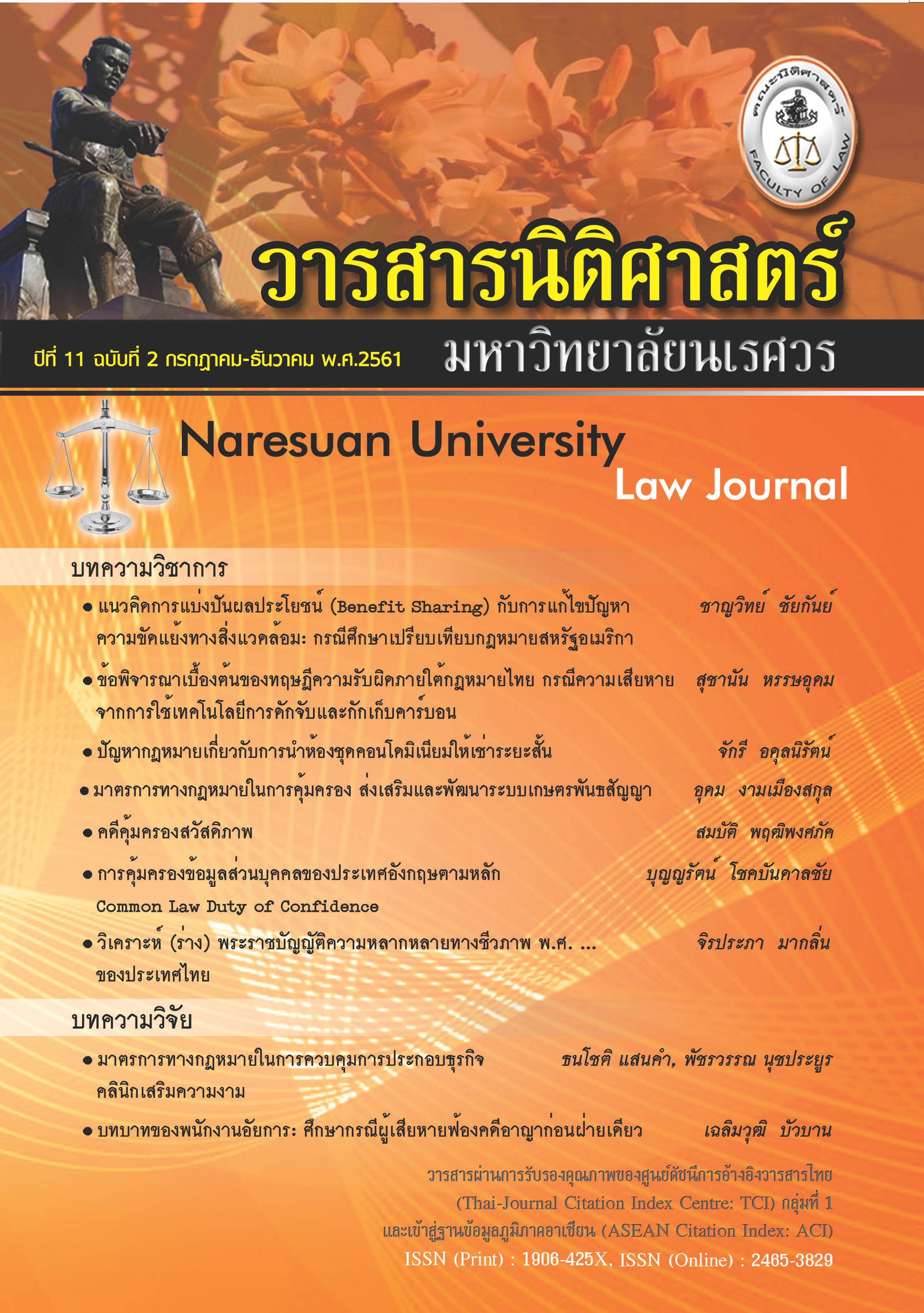Preliminary Analysis of Liability Theories under Thai Law for Damage Arising from Carbon Capture and Storage (CCS)
Main Article Content
Abstract
The increase in energy consumption from fossil fuel utilisation now is recognized as a cause of climate change. Problems have occurred as a result of carbon dioxide (CO2) emission into the atmosphere. There are several techniques introduced to deal with this problem, including the use of Carbon Capture and Storage (CCS) which could reduce the CO2 levels in the atmosphere. Nowadays, CCS is being used in many countries; including the United States and Australia. In addition, in some country has been legislated the particular law for CCS such as EU CCS Directive. Although CCS helps reduce the amount of CO2 in the atmosphere, it may also generate some negative consequences and risks. In the future, therefore, if CCS is used in Thailand, consideration should be given to how the law can deal with the problems that may arise from the CCS technique.One possible legal response is the use of liability law. This paper considers liability law in Thailand regarding CCS. This study shows that existing Thai laws can address the problems of CCS. These laws include theories of fault-based liability under Section 420 of the Thai Civil and Commercial Code, nuisance liability under Section 1337 of the Thai Civil and Commercial Code, and liability for pollution leakage under Section 96 and 97 of the Enhancement and Conservation of the National Environmental Quality Act, B.E.2535 (1992). This study also shows that some legal theories and laws could not apply to CCS: for instance; strict liability for damage caused by dangerous property under Section 437 of the Thai Civil and Commercial Code, or the liability provisions under the Hazardous Substance Act, B.E.2535 (1992).
Article Details
References
Climatological Center. “What is the Climate Change?.” Accessed May 11, 2018. https://climate.tmd.go.th/content/article/9. [in Thai]
Department of International Organization, Ministry of Foreign Affairs. “Paris Agreement: the Important Steps to Tackle Climate Change.” Accessed May 27, 2018. https://www.mfa.go.th/thai_inter_org/th/services. [in Thai]
Faure, Michael G., and Roy A. Partain Carbon Capture and Storage Efficient Legal Policies for Risk Governance and Compensation. N.P.: The Mit Press, 2017.
Flatt, Victor Byers. “Paving the Legal Path for Carbon Sequestration.” Duke Environmental Law and Policy Forum 19 (2009): 211-246.
Letter Planet. “The advantages of Carbon Dioxide in Industrial.” Accessed May 10, 2018. https://letterplanet.com/content/772/ก๊าซคาร์บอนไดออกไซด์มีความสำคัญอย่างไรในโรงงานอุตสาหกรรม. [in Thai]
Morgan, M. Granger, and Sean T. Mccoy. Carbon Capture and Sequestration Removing the Legal and Regulatory Barriers. New York: Resources for the Future, Taylor and Francis, 2012.
Sak Sanongchart. Tort Guide Book: Tort and Tort Liability. 9th ed. Bangkok:NitiBannakarn, 2003. [in Thai]
Sawang Kerdpratom, Department of Engineer. “Thailand Institute of Scientific and Technological Research, “Carbon Dioxide.” Accessed May 26, 2018. https://www.tistr.or.th/ed/?p=566. [in Thai]
Seni Promoj. Civil and Commercial Code Book: Property. Bangkok: Aksornniti, 1936. [in Thai]
Somchai Teekauttamakorn. Civil and Commercial Code Book: Property. Bangkok:Pholsiam Priting, 2012. [in Thai]
The IEA Greenhouse Gas R&D Programme. “A Brief History of CCS and Current Status.”Accessed August 9, 2018. https://ieaghg.org/docs/General_Docs/Publications/Information_Sheets_for_CCS_2.pdf.
Udomsak Sinthipong. (2011). Environmental Law. 3rd ed. Bangkok: Winyuchon. [in Thai]


